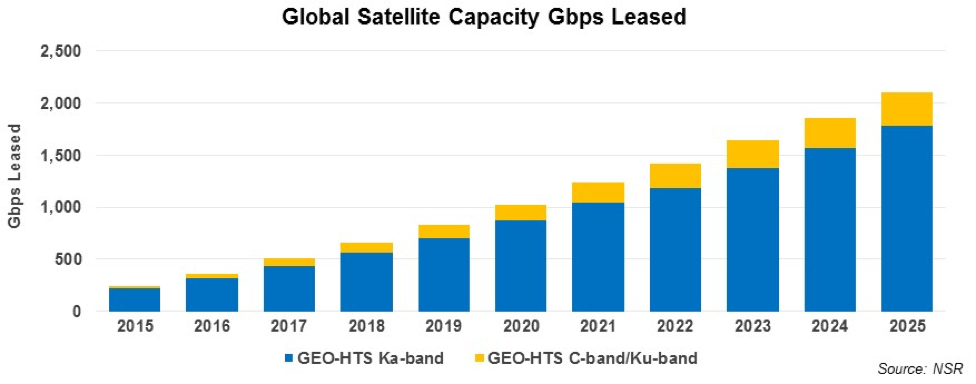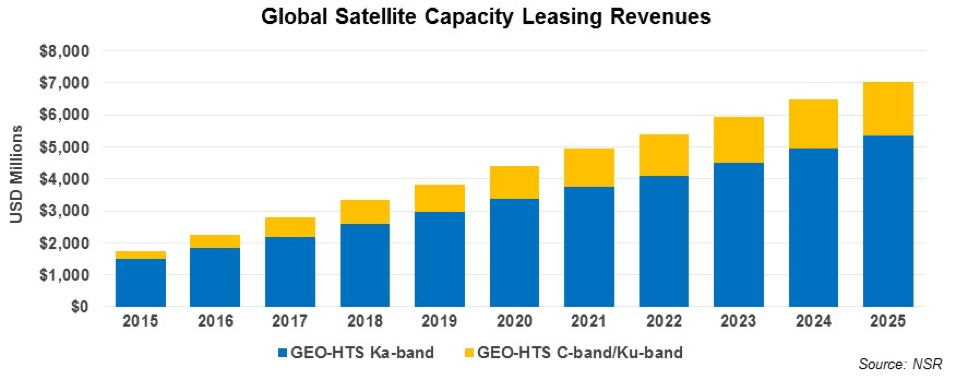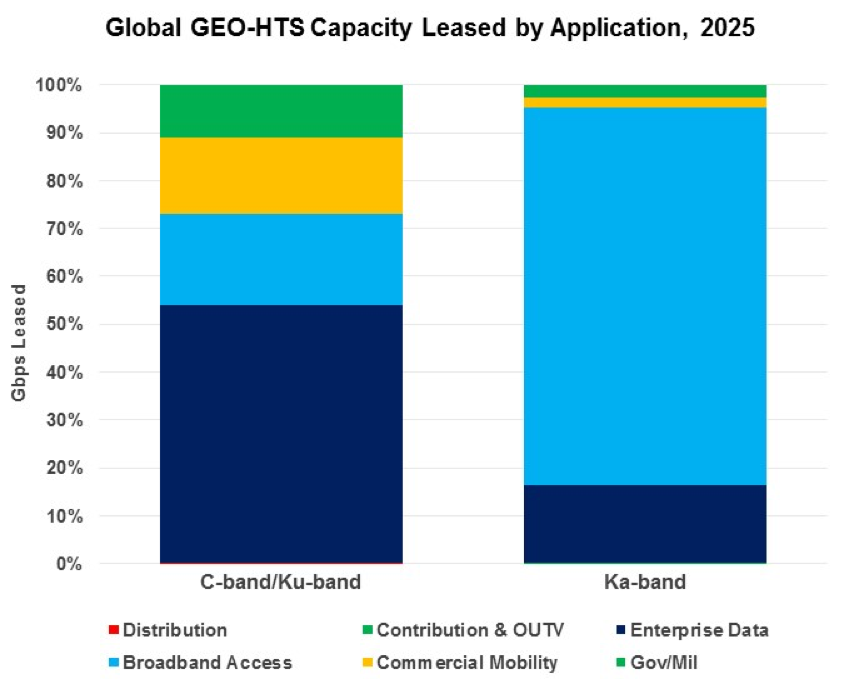Joining
Together with the Band(s)
Oct
5th, 2016
by
Blaine Curcio, NSR
Over the past few weeks, we
have seen top satellite executives
seemingly coming to terms
with the fact that
lower
prices are here to stay,
and that the evolution of the satellite
telecom business model from FSS towards
HTS—at least in terms of the best growth
opportunities—is well underway. While
NSR does not dispute that video will
remain a beacon for steady growth and
long-term contracts in developing
countries, and a bastion of stability in
developed ones,
we have noted
for some time that GEO-HTS will provide
the best opportunities.
When looking at
NSR’s
Global Satellite Capacity Supply &
Demand, 13th Edition,
it becomes clear that not all
GEO-HTS capacity is created equal.
As some industry insiders have recently
discussed, the promise of Tbps
satellites worldwide should not
unequivocally signal the downfall of
traditional FSS—and should by no means
close the door on the GEO-HTS systems of
tomorrow that are being launched with a
decidedly more modest payload of dozens
of Gbps, rather than Tbps. Indeed, when
looking at these future GEO-HTS
payloads, we can in many cases divide
them into
C-band/Ku-band HTS payloads,
such as the SES-12/14/15 system,
Intelsat Epic, IPSTAR, and so on, and
Ka-band HTS
payloads,
such as ViaSat-1/2/3, Jupiter-1/2, and
Ka-Sat. As the chart below shows,
clearly GEO-HTS Ka-band
wins outright
as it relates to capacity leased,
with
around 87% of the GEO-HTS market by
leased Gbps by 2025.

When looking at future GEO-HTS
payloads, the first point to keep in
mind is that
GEO-HTS
Ka-band capacity will see lower prices
on a per Mbps basis.
This comes
about due to two factors, namely 1)
GEO-HTS Ka-band tends to primarily
target consumer broadband, which is
lower price capacity, and 2) there
remain, in some regions and for some
applications, doubts about the
suitability of Ka-band for high-SLA type
requirements, and there is in general a
“new product bias” associated with
Ka-band in some cases. In short, many
customers are generally happy with what
they have, and thus will stick with the
path of least resistance, which in some
cases is a slightly higher per-Mbps
backward migrated C-band/Ku-band GEO-HTS
service, particularly when this service
ends up being cheaper than a comparable
FSS service. As such, and as the chart
below indicates, GEO-HTS C-band and
Ku-band combined will comprise around
25% of GEO-HTS revenues by 2025, or
around $1.7 billion.

Ultimately,
GEO-HTS
C-band and Ku-band will have a far more
balanced demand profile than GEO-HTS
Ka-band,
with the
former seeing stronger demand from
applications such as Enterprise Data and
to some extent Commercial Mobility and
Gov/Mil. As the below chart shows,
around 80% of GEO-HTS Ka-band capacity
demand will come from consumer broadband
access, compared to around 20% for
GEO-HTS C-band/Ku-band. While NSR does
expect the price advantage, as well as
the
sheer volume
of GEO-HTS Ka-band capacity
to
cause some customers to migrate, we have
thus far not
seen this as being the case
in
instances that may have otherwise
dictated migration. For example,
Avanti Communications has been present
in Africa for some time now with
low-cost Ka-band HTS capacity,
yet
the company has not been able to
capitalize on lower prices and has been
brought the point of potential
acquisition due to cash requirements in
the UK.

Bottom Line
Moving
forward, it is vital to understand that
not all
GEO-HTS capacity is created equal.
While there may be
orders of
magnitude more GEO-HTS Ka-band capacity
being launched in all/most regions,
this will not necessarily be able to
convert all customers from all
applications solely due to the promise
of lower bandwidth costs. While there
will
certainly be
pressure on pricing in all frequency
bands and all capacity types,
NSR does not expect GEO-HTS Ka-band to
be the end-all, be-all solution. Moving
forward,
a more
nuanced picture will emerge,
with
GEO-HTS Ka-band being able to convert
and build new markets in areas such as
consumer broadband—and in many cases,
Enterprise Data—but with GEO-HTS C-band
and Ku-band being able to command
a
significant market of legacy customers
migrating to lower-cost GEO-HTS, as well
as new verticals ranging from backhaul
to aero.
In a
multi-band world, NSR expects
each
band to present unique value
propositions to unique customer bases.